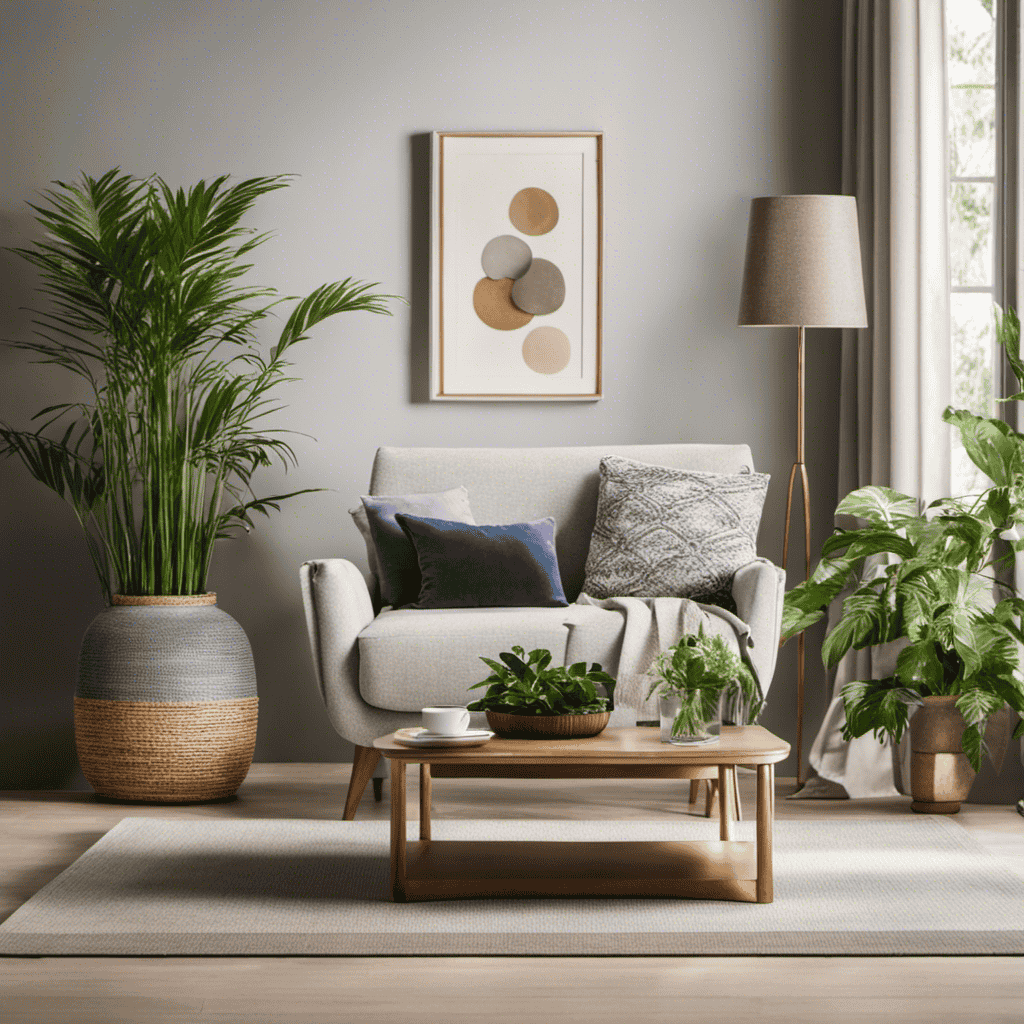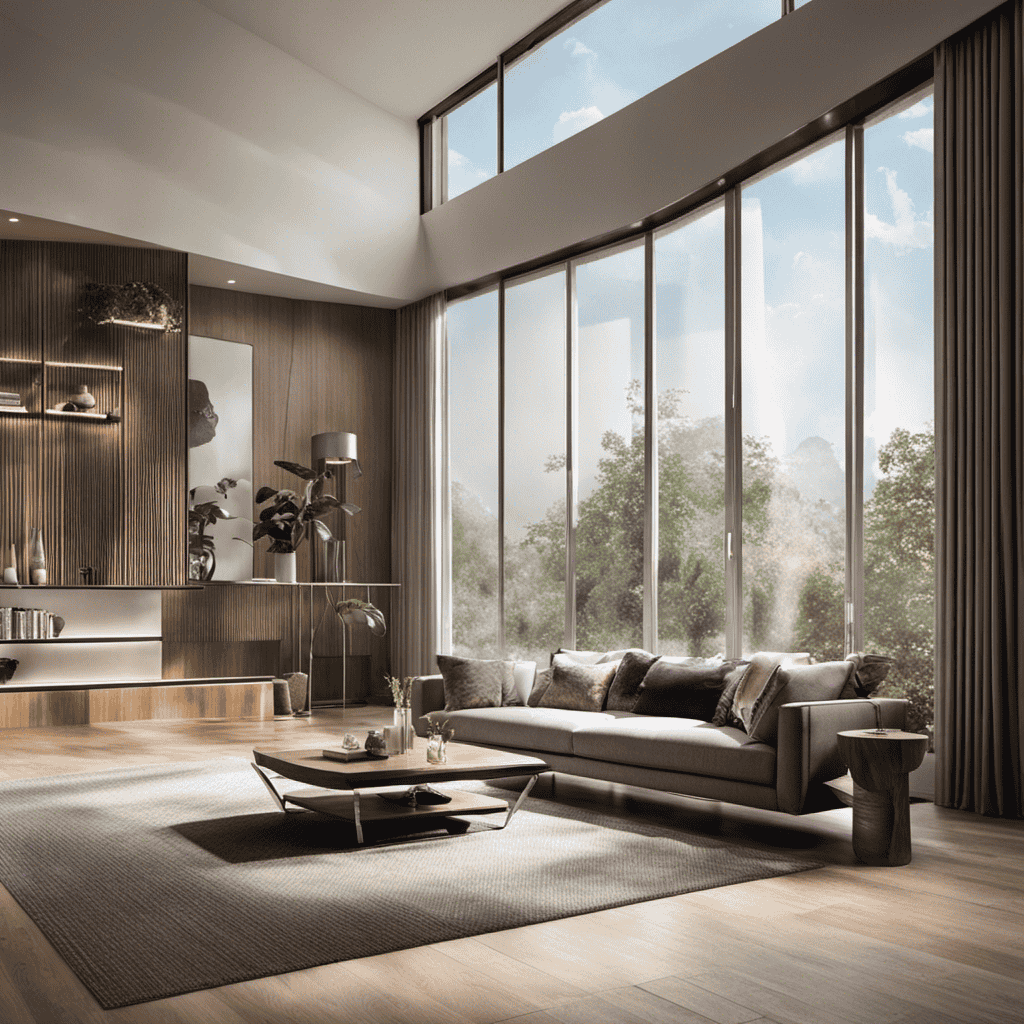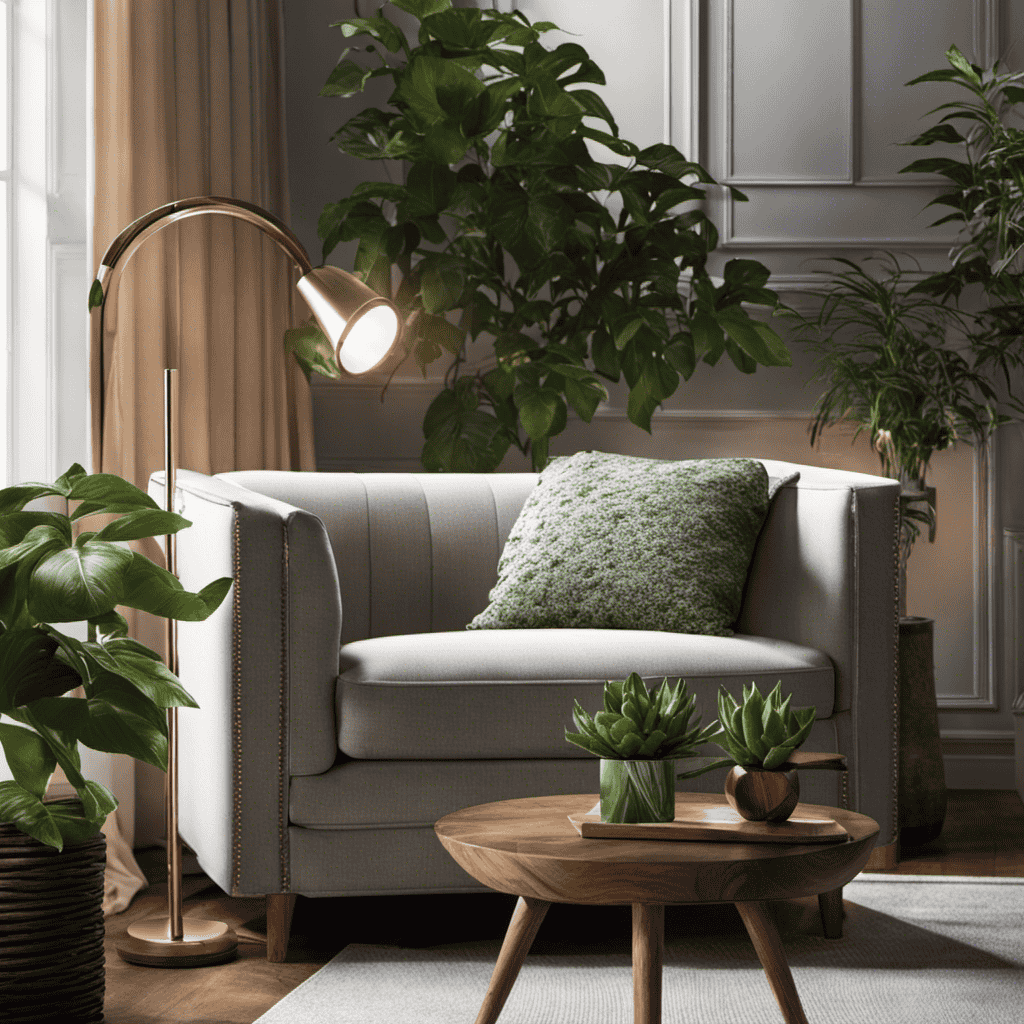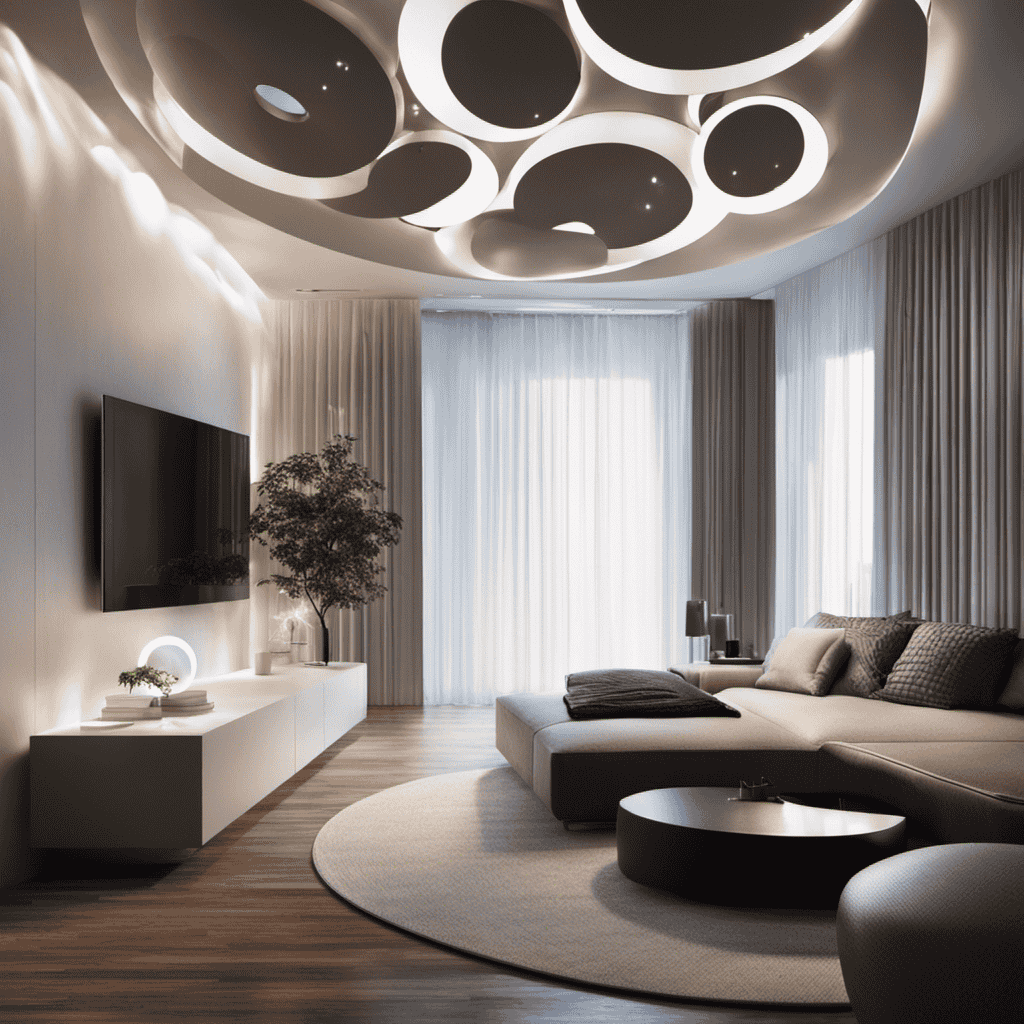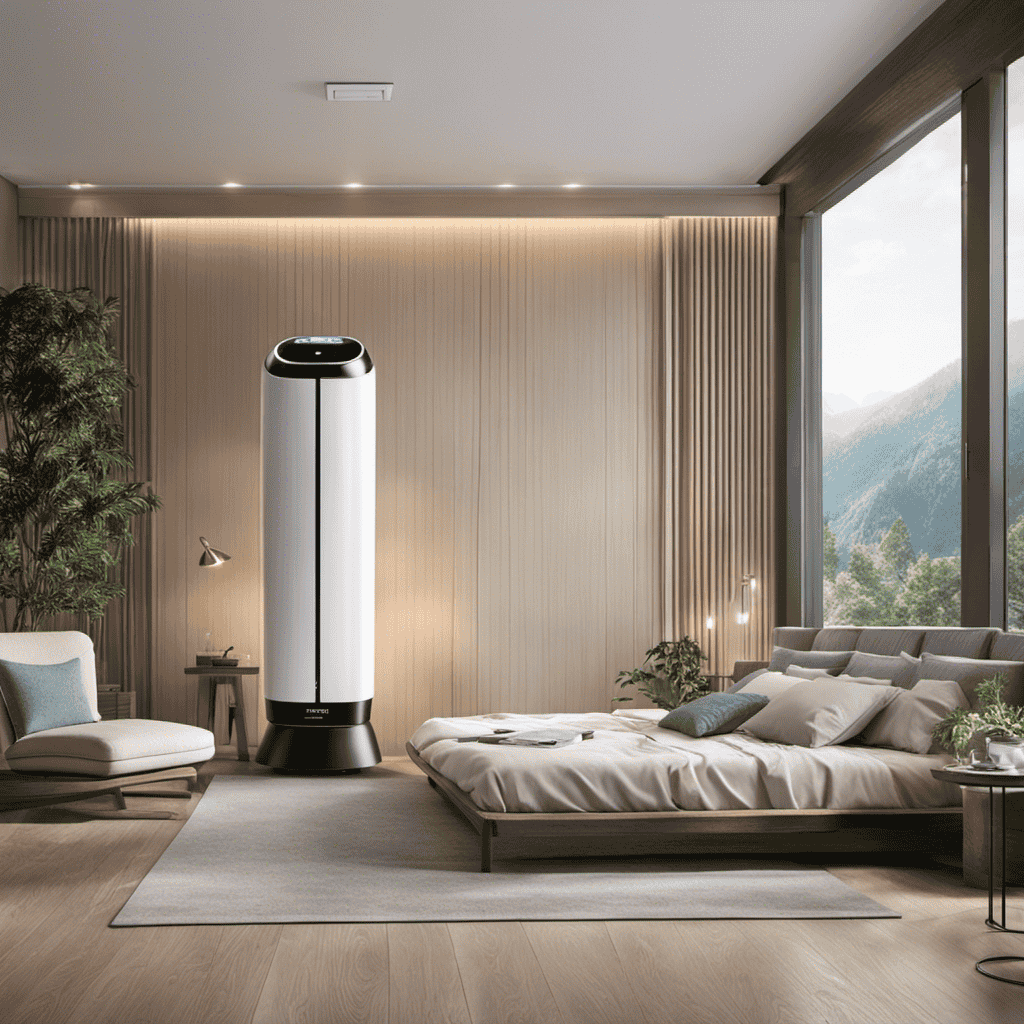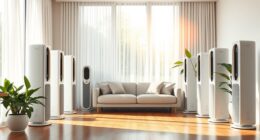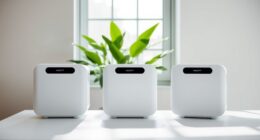As I search for ways to improve the air quality in my home, I am considering the optimal location for my air purifier. This article will discuss the key factors to think about when determining the best placement for this important device.
From evaluating room size and airflow to identifying potential pollutant sources, I will provide evidence-based analysis to help guide your decision.
So, let’s dive in and uncover the optimal positioning for your air purifier.
Key Takeaways
- Evaluate noise levels and consider the impact of air purifier placement.
- Position the air purifier in a central location in the room for optimal air circulation.
- Avoid placing the air purifier behind furniture or curtains to ensure unobstructed airflow.
- Place the air purifier away from electronics to prevent interference with filters.
Consider the Room Size
When choosing where to put the air purifier, you’ll need to consider the size of the room. Evaluating noise levels and considering furniture placement are important factors to take into account.
Firstly, noise levels should be evaluated when deciding where to place the air purifier. A loud purifier in a small room can be distracting and disrupt your peace. On the other hand, a larger room may require a purifier with higher noise levels to effectively clean the air. It is essential to strike a balance between the purifier’s noise and the room’s size to ensure a comfortable and quiet environment.
Additionally, furniture placement should also be considered when determining the best location for the air purifier. Placing it near furniture that obstructs airflow can hinder its effectiveness. It is recommended to position the purifier in an area where it has ample space to circulate the air efficiently and reach all corners of the room.
Evaluate Airflow and Ventilation
When it comes to air purifiers, optimal air circulation is key to effectively remove pollutants from the air. To achieve this, it is important to avoid obstructing the airflow by placing the purifier in an open area with no obstructions in front or around it.
Strategic placement considerations should also be taken into account, such as positioning the purifier near potential sources of pollutants, like cooking areas or pet spaces, to ensure maximum efficiency.
Optimal Air Circulation
To maximize the effectiveness of your air purifier, make sure it’s placed in an area where there is optimal air circulation. This will help ensure that the purifier can effectively capture and remove pollutants from the air.
Here are three key factors to consider when optimizing airflow:
-
Distance from obstacles: Keep your air purifier at least a few feet away from walls, furniture, and other objects that may obstruct the flow of air. This allows for better distribution of purified air throughout the room.
-
Height placement: Position the air purifier at a higher level, such as on a table or shelf, to take advantage of the natural movement of air. This can help improve the overall circulation and reach of the purifier.
-
Centralized location: Place the air purifier in the center of the room, if possible. This allows for more even distribution of purified air and ensures that all corners of the room receive adequate air circulation.
Avoid Obstructing Airflow
Make sure you don’t place any objects near the air purifier that could obstruct the airflow and hinder its performance.
When it comes to the placement of your air purifier, it’s essential to consider factors such as noise levels and maintenance accessibility.
Evaluating noise levels is crucial because a noisy air purifier can be distracting and disruptive to your daily activities. Look for models that offer quiet operation, especially if you plan to use the purifier in a bedroom or office setting.
Additionally, assessing maintenance accessibility is important for easy cleaning and filter replacement. Choose a location that allows you to easily access the purifier for regular maintenance tasks.
This will ensure that your air purifier continues to function effectively and efficiently.
Strategic Placement Considerations
You should consider the layout and size of the room when deciding where to place your air purifier. Strategic placement is important for evaluating the effectiveness of the purifier and ensuring optimal air quality throughout the room.
Here are some key considerations:
-
Room size: If you have a larger room, you may need a purifier with a higher CADR (Clean Air Delivery Rate) to effectively clean the air. Smaller rooms can benefit from smaller, compact purifiers.
-
Airflow direction: Placing the purifier near a wall or furniture can obstruct airflow and reduce its efficiency. Make sure to keep a clear space around the unit for proper air circulation.
-
High-traffic areas: Positioning the purifier in areas where people spend most of their time, like living rooms or bedrooms, can help ensure that the air they breathe is continuously purified.
Assess Potential Pollutant Sources
Assessing potential pollutant sources is crucial when determining where to place the air purifier. To ensure the effectiveness of the purifier, it is essential to assess the indoor air quality and identify common indoor pollutants.
Some common indoor pollutants include volatile organic compounds (VOCs) from cleaning products and furniture, allergens like dust mites and pet dander, and pollutants from cooking and smoking. These pollutants can have adverse effects on our health, such as respiratory issues and allergies.
By assessing the sources of these pollutants, we can strategically place the air purifier in areas where the concentration of pollutants is highest. This will allow the purifier to efficiently capture and remove the pollutants, ensuring cleaner and healthier indoor air.
Taking note of high-traffic areas, where pollutants are more likely to be introduced, is especially important in determining the optimal placement of the air purifier.
Take Note of High-Traffic Areas
After assessing potential pollutant sources in my home, it’s important to take note of high-traffic areas when deciding where to place the air purifier. These areas tend to have more dust, allergens, and pollutants circulating in the air. Here are some key considerations for evaluating room size and furniture placement:
-
Room size evaluation: Determine the square footage of the room to ensure the air purifier is powerful enough to effectively clean the air. Larger rooms may require a higher CADR (Clean Air Delivery Rate) to cover the entire space.
-
Furniture placement considerations: Keep in mind that furniture can obstruct the airflow of the air purifier. Avoid placing the unit behind large pieces of furniture or in corners where air circulation may be limited.
-
Optimal positioning: Place the air purifier in a central location within the room to maximize its effectiveness. This allows for better air circulation and ensures that the purifier can capture pollutants from all areas.
Considering these factors will help me make an informed decision on where to place the air purifier and ensure that it efficiently improves the air quality in my home.
Now, let’s delve into the next section and discuss the importance of minding the furniture placement.
Mind the Furniture Placement
When considering furniture placement, it’s crucial to ensure that the air purifier has unobstructed airflow for optimal performance. The way you arrange your furniture can greatly affect the air quality in your home. To help you make informed decisions, let’s take a look at the impact of furniture arrangement on air purifier effectiveness.
| Furniture Placement | Air Purifier Performance |
|---|---|
| Near Walls | Restricted airflow |
| Behind Curtains | Limited air circulation |
| Beside Electronics | Interference with filters |
Placing your air purifier near walls can restrict airflow, reducing its effectiveness. Similarly, positioning it behind curtains can limit air circulation. Additionally, placing the air purifier beside electronics can lead to interference with its filters. To maximize the benefits of your air purifier, consider placing it in a central location in the room with ample space around it. This will allow for unobstructed airflow and ensure that the purifier can effectively clean the air in your home.
Check for Windows and Doors
Proper ventilation is crucial for the effectiveness of an air purifier. Without adequate airflow, the purifier may not be able to effectively remove pollutants from the air.
To ensure proper ventilation, it is important to avoid disruptions in air flow, such as placing the purifier near obstructions like furniture or curtains.
Proper Ventilation for Effectiveness
To maximize the effectiveness of your air purifier, make sure you have proper ventilation in the room. Good ventilation plays a crucial role in the overall performance of your air purification system. Here are three reasons why proper ventilation is important:
-
Improved Air Circulation: Proper ventilation helps in circulating the air in the room, allowing the air purifier to capture more pollutants and allergens effectively. It prevents stagnant air and ensures that the purified air is evenly distributed throughout the space.
-
Reduction of Indoor Air Pollution: Ventilation helps in removing indoor pollutants such as volatile organic compounds (VOCs), odors, and smoke. When these contaminants are properly ventilated, the air purifier can focus on capturing smaller particles like dust, pollen, and pet dander.
-
Prevention of Condensation and Mold Growth: Good ventilation helps to control humidity levels and prevent condensation. Excessive moisture in the air can lead to mold growth, which can impact the air quality and reduce the effectiveness of your air purifier.
Evaluating the effectiveness of your air purifier relies on proper ventilation. By ensuring adequate airflow and placement of your air purifier near sources of pollution, you can maximize its performance and enjoy cleaner and healthier air.
Avoid Air Flow Disruptions
Make sure you don’t block or obstruct the airflow around your air purifier, as this can disrupt its performance.
Proper placement of the air purifier is crucial to ensure optimal functionality. When evaluating noise levels, it is important to consider the impact of air purifier placement.
Placing the air purifier in a location where it has adequate space to circulate air without any obstructions is key. This allows for efficient air purification and helps to minimize noise levels.
Additionally, positioning the air purifier near sources of pollutants, such as pet areas or kitchens, can further enhance its effectiveness.
Think About Noise Levels
Consider placing the air purifier in a location where the noise levels won’t disturb you. Noise levels can vary depending on the type and model of the air purifier, so it’s important to take this into consideration when deciding where to place it in your home.
Here are three factors to consider when thinking about noise levels and furniture placement:
-
Distance: Keep the air purifier at a reasonable distance from where you spend most of your time. This will help reduce the noise impact and ensure that you can enjoy a peaceful environment.
-
Obstacles: Avoid placing the air purifier behind large furniture or objects that could obstruct the airflow. This can lead to increased noise levels as the purifier works harder to circulate the air.
-
Room layout: Consider the layout of your room and place the air purifier in a central location. This will help distribute the purified air evenly throughout the space, while minimizing noise disruptions.
Consider Accessibility for Maintenance
When considering the placement of an air purifier, it’s important to think about accessibility for maintenance. The ease of accessing the unit for regular cleaning and filter replacement can greatly impact its overall effectiveness.
Ideal placement would involve strategic positioning that allows for easy and convenient maintenance, ensuring that the air purifier can continue to operate at its optimal performance levels.
Maintenance Accessibility Importance
It’s important to have easy access for maintenance of the air purifier. Proper maintenance is crucial for ensuring the longevity and effectiveness of the device in improving air quality. Here are three reasons why maintenance accessibility is important:
-
Regular Filter Replacement: Air purifiers have filters that need to be replaced periodically. Having easy access to the purifier allows for quick and hassle-free filter changes, ensuring optimal performance and air quality improvement.
-
Cleaning and Dusting: Air purifiers can accumulate dust and debris over time. Easy access makes it convenient to clean and dust the device regularly, preventing clogs and maintaining its efficiency in removing airborne particles.
-
Inspection and Troubleshooting: Regular inspection and troubleshooting are essential for identifying any issues with the air purifier. With easy access, it becomes easier to perform these tasks, ensuring timely repairs and uninterrupted air purification.
Ideal Placement for Accessibility
For optimal accessibility, it’s best to place the air purifier in a location that is easily reachable for maintenance. When considering where to put your air purifier, it’s important to take into account the room layout and the ease of filter replacement.
The placement of the air purifier can greatly affect its effectiveness in purifying the air and its overall performance.
One key factor to consider is the proximity to the main source of pollutants in the room. If there are specific areas or objects in the room that tend to produce more dust or odors, it is advisable to place the air purifier nearby to effectively capture and filter these pollutants.
Additionally, easy access to the air purifier is crucial for regular filter replacement. Filters play a vital role in trapping and removing airborne particles, allergens, and pollutants. Over time, these filters can become clogged and less effective. Therefore, placing the air purifier in a location that allows for easy access and hassle-free filter replacement is essential for maintaining optimal air quality.
Keep Away From Heat Sources
To avoid any potential risks, do not place the air purifier near heat sources like radiators or stoves. Heat sources can not only damage the air purifier but also pose a fire hazard. It is important to maintain a safe distance between the purifier and any heat-emitting devices.
Here are three reasons why this is crucial:
-
Room Size: Placing the air purifier near a heat source can disrupt the airflow and ventilation in the room. This can result in uneven distribution of purified air, making it less effective in larger spaces.
-
Airflow: Heat sources generate warm air currents that can interfere with the air purifier’s ability to effectively clean the air. This can reduce its overall performance and limit its ability to remove pollutants.
-
Ventilation: Heat sources can affect the overall ventilation of the room. Proper ventilation is essential for the air purifier to circulate clean air throughout the space, ensuring optimal air quality.
Seek Expert Advice if Needed
If you have any doubts or concerns about where to place your air purifier, don’t hesitate to seek advice from an expert.
Expert consultation can provide valuable insights and help you make an informed decision.
There are various factors to consider when determining the best location for your air purifier, such as the size of the room, the presence of allergens or pollutants, and the layout of furniture.
An expert can assess your specific situation and provide personalized recommendations based on scientific evidence and expertise.
They can guide you on the ideal placement to maximize the air purifier’s effectiveness and ensure optimal air quality in your living space.
Frequently Asked Questions
Can I Place the Air Purifier Near a Heat Source?
Placing the air purifier near a heat source is not recommended. Heat sources can affect the performance of the purifier and potentially cause damage. It’s best to keep the purifier in a cool, well-ventilated area.
How Do I Assess Potential Pollutant Sources in My Home?
Assessing indoor air quality involves identifying common household pollutants. I start by looking for potential sources like cleaning products, smoking, and poor ventilation. It’s crucial to tackle these issues to ensure a healthier living environment.
Should I Consider Noise Levels When Choosing a Location for My Air Purifier?
Considering the size of the room and evaluating filter effectiveness are important factors to consider when choosing a location for my air purifier. Noise levels should also be taken into account to ensure a comfortable environment.
Is It Necessary to Seek Expert Advice When Determining the Placement of My Air Purifier?
Seeking expert advice and conducting thorough research are crucial when determining the placement of an air purifier. It ensures optimal performance and effectiveness in providing clean air for my home.
How Do I Evaluate the Airflow and Ventilation in a Room Before Deciding Where to Put the Air Purifier?
Evaluating airflow and ventilation is crucial before placing an air purifier. Assessing airflow patterns and conducting a ventilation evaluation helps determine the most effective location for optimal air purification.
Conclusion
In conclusion, when it comes to placing an air purifier in your home, it is essential to consider various factors. By evaluating the room size, airflow, and potential pollutant sources, you can make an informed decision.
Additionally, keeping in mind high-traffic areas, furniture placement, and noise levels will ensure the optimal placement of the air purifier. Accessibility for maintenance and keeping it away from heat sources are also crucial.
If you need further guidance, seeking expert advice can be beneficial. Remember, a well-placed air purifier can effectively improve indoor air quality and provide a healthier living environment.
